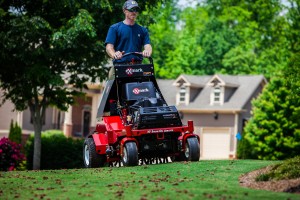(StatePoint) Fall is a great time to aerate the lawn. Whether you do it yourself or hire a lawn care professional to do it for you, aeration at least once per year provides a number of benefits to your lawn, say experts.

An increasing number of landscape professionals are turning to productivity-enhancing machines like this Exmark 30-inch Stand-On Aerator. The stand-on design also reduces operator wear and tear significantly.
The main benefit is to relieve compaction and increase pore space, which promotes gas exchange and microbial activity in the soil and creates a better, more supportive environment for lawn health and vitality. Aeration also promotes better soil drainage, which helps keep disease at bay and allows more water to percolate into the soil from rain or irrigation, meaning less runoff and more water getting where it needs to go.
“Ideal aeration timing depends on turf type and geography,” says Lloyd Von Scheliha of Exmark Manufacturing, a manufacturer of turf care equipment. “But annual aeration provides valuable agronomic benefits to virtually any turfgrass.”
With that in mind, here are some tips from the experts at Exmark to get the most benefits from aeration:
• Timing: Ideally, aeration should take place during times of active growth to help with recovery. Avoid aeration during times of heat stress or times preceding dormancy. It’s typically best to aerate cool season grasses in the spring or fall, while with warm season grasses, it’s best to aerate in late spring or early fall.
• Proper equipment: Use gear that meets the needs of your lawn. For example, Exmark offers a 30-inch Stand-On aerator that makes quick work of even large properties with the ability to easily maneuver around landscape features.
• Follow-up: After aeration, it’s a good idea to water the lawn, as well as a good time to apply fertilizer or overseed if needed. Be careful not to apply a pre-emergent if you plan to overseed, however, as it will prevent the new seed from growing.
Don’t let this important, but often overlooked lawn care task escape your attention this season. At the ideal time for your lawn, either take it upon yourself or hire a professional to give your grass a better chance at thriving.






